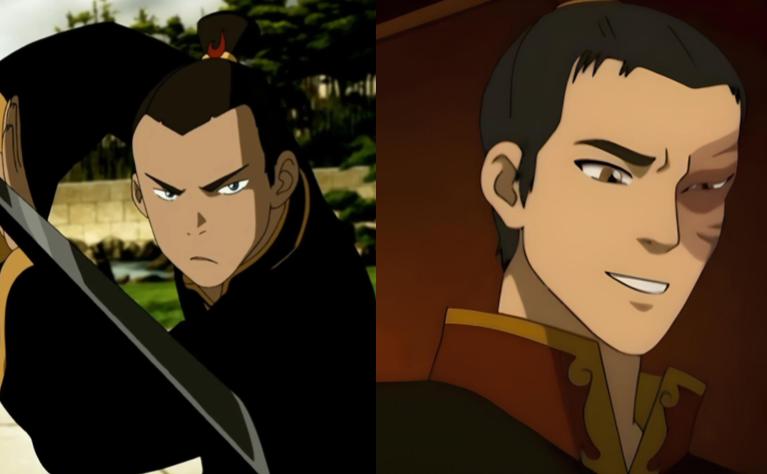Some character arcs are more dramatic than others. They’re the redemption arcs that you’ll never forget. The ones with choices so difficult that you wonder if you’d ever be able to make a choice like that, too. The moments when the characters fail, and it almost crushes you, and then they finally turn and make the choice you’ve been hoping they would all along.
Zuko’s character arc is one of those. If you ask any Avatar fan about their favorite redemption arc, Zuko instantly comes to mind. Moments of his incredible journey — from starting the series as the main antagonist and heir of a country intent on burning the world to becoming a much-needed ally and possibly most dedicated force for good — stand out like gems. His entire arc is punctuated by scenes when everything he thought he knew is challenged, when he’s forced to make a choice at a time when he’s least ready for it, and when he tries to do the right thing and ends up facing the greatest obstacles of his entire life.
But not every character arc can be as dramatic. Not every character starts out as an antagonist before becoming one of the hero’s biggest assets. So how can we make sure those character arcs are just as memorable for our readers?
We’ve recently talked on the blog about the two different kinds of character arcs, but we’ve yet to look at how to execute them. And to explore just that, we’ll look at two of the character arcs in Team Avatar: Sokka’s and Zuko’s.
Zuko’s Character Arc
Prince Zuko is the son of the vicious Firelord Ozai and heir to the throne of the Fire Nation — that is, until he is banished from his homeland and promised a life of exile until he can find and capture the powerful Avatar. The only threat to his father’s power and his family’s dynasty is the Avatar, who has the power to wield all four elements and a duty to maintain balance between the four corresponding nations. And that balance requires stopping the Fire Nation’s 100-year war against the other countries.
With only a single navy ship and crew, Zuko sets out with his wise Uncle Iroh to find and capture the Avatar. But Zuko has no patience for his Uncle’s peaceful ways and no humility to learn from his wisdom. When he finally locates the Avatar, he spares no time, resource, or energy hunting him across the globe. In spite of his Uncle’s advice, he reacts harshly to his crew, impulsively toward his enemies, and defensively even toward those trying to help him.
But eventually even Zuko’s impenetrable cruelty and drive are worn down, and Iroh is able to show him the wisdom he has rejected for so long. He sees firsthand the suffering that the Fire Nation has inflicted on the world and begins to question if continuing the war is right. When he is finally offered a choice between helping the Avatar restore balance to the world or receiving his father’s approval and achieving the honor he has so long sought after, he chooses to revert back to his old habits, betraying even Uncle Iroh in his determination to win back the honor he’s lost.
But back home, crowned Heir to the Throne and Prince of the Fire Nation, Zuko finds the luxury, approval, and honor he once desired to be empty. He’s angry at everyone and he doesn’t understand why, until a search through the archives reveals something he was never told — through his father, he is descended from a line of cruel dictators. But his mother is the granddaughter of the previous Avatar.
His destiny isn’t as permanent as he thought, and even his bloodline holds whispers of the conflict he’s held inside for so long. He realizes that despite the choices he’s made in the past, he still has a choice to make in the present.
And finally he decides to leave everything to help the Avatar stop his own father and restore peace throughout the world.
Sokka’s Character Arc
Sokka is the egotistical and sexist teenage brother of the last waterbender in the entire South Pole, Katara. He feels an immense duty to protect her and his tribe since all of the other men left to fight the war when he was too young to join. He sees himself as the last outpost and protection of his home, which makes it impossible for him to see himself as a failure. That would mean he’d failed his sister, his entire tribe, and his father (who’s been courageously fighting the Fire Nation for years, now.) Hence the ego and sexism.
But when a band of female warriors shows him up in just about everything he prides himself on, he begins to look at the world in a new way. And, for the first time, we get a hint of humility from him when he apologizes to them for his arrogance and asks to be taught how to better defend his family.
Although this is the loudest example of it, Sokka’s far more subtle journey to finding his true identity and purpose is riddled with quieter examples of how he grows to understand what courage, manhood, and identity are. One by one, he’s deprived of the less-important things he once tied his identity to, from being forced to hide the fact that he’s from the Water Tribe to losing his trusty boomerang.
But the Sokka that leads the charge against the Fire Nation airships in the final battle of the series is a completely different character than the one who ridiculed his sister, constantly fought for authority, and felt insulted by the slightest challenge to his courage, prudence, or capacity for leadership. Although he didn’t have to fight his own family and legacy to achieve this change, it is just as dramatic as Zuko’s.
And yet when I talk about Sokka’s arc, few dramatic, mid-series scenes come to mind. He’s never been forced to question everything he knows or determined his destiny on his own despite the beliefs of everyone around him. Instead, Sokka was given a much quieter, more subtle arc than Zuko’s, with fewer fiery monologues or heart-wrenching sacrifices. He sacrificed his ego in choosing to humble himself before the Kyoshi Warriors, but that might be the only scene that shows Sokka’s changes mid-journey.
So what made his arc so powerful?
The Subtle Character Arc and the Dramatic Character Arc
There are two different ways to execute a character arc, but, unlike some of the other categorizations for storytelling we’ve talked about on the blog recently, you don’t have to pick one. Most character arcs actually have elements of both.
Katara’s is an example. She’s faced with several dramatic, character-defining choices, from challenging Master Pakku to choosing to spare her mother’s murderer. But she also has many, far quieter moments that end up defining what kind of a person she is at the end of the series. The hours spent perfecting her waterbending and mentoring the other members of their group define her just as much as those more dramatic scenes.
So if Zuko’s arc is on one end, Sokka’s arc is on the other, and Katara’s lies somewhere in the middle, which is best? Which should we, as writers, choose for each of our characters?
The truth is that neither is better than the other. Both can be powerful, and both come with unique challenges.
The Dramatic Character Arc can tend toward, well, drama. Sometimes these arcs can appear overdone, or the waffling between good and evil and repeated, dramatic choices can seem needless. The emotional whiplash can begin to feel exhausting, which is one of the more annoying feelings when reading. Avoiding these pitfalls to write an arc like Zuko’s could make a whole other article in itself (and I already have one along those lines in the works!) So instead of addressing all that, today we’re going to focus on how you can make your character’s Subtle Arc just as powerful as the Dramatic ones.
The Subtle Character Arc
Although the Subtle Character Arc doesn’t have great, mid-story choices or changes accompanied by long monologues or dramatic revelations, they can be made just as powerful by intentional choice placement at the end of the story. A character choosing to do the right thing when it matters the most at the end of the series can more than make up for the other opportunities for explosive choices along the way. The dozens of smaller, less significant choices eventually add up to give your character the opportunity to make the climax especially powerful.
One of the reasons this kind of arc is so incredible is because, in some ways, it’s more true-to-life. Unlike most story characters, the changes we experience most often happen through dozens or hundreds of little choices we make every day — either for bad or good.
C. S. Lewis talks about this. He believes every, miniscule, infinitesimal choice that we make is either a step forward or backward — and all those little decisions add up to create the person that we become. For our characters, these choices add up to make up the bigger choices they are forced to make when the climax comes.
These arcs are all the more powerful because they are realistic. They can be hard to spot at first, but once you find them they pop up everywhere — from Elinor in Sense and Sensibility to Grunkle Stan in Gravity Falls. These characters’ choices are small and subtle, their arcs at times hard to notice. But in the end they can be just as powerful as their more dramatic counterparts. And through choices so small that they seem at first insignificant, they create some of the most significant character arcs in literature.



Hey! We have a special announcement!
Do you like Avatar content? If so, we invite you to A Month In Ba Sing Se this September, with a series of articles all about Avatar: The Last Airbender, and what we can learn from The Tales of Ba Sing Se.


Hi! My name is Mara, and I’m a Christian artist, violinist, and blogger. I remember the day that I decided that I would learn something new about what makes a good story from every book I picked up — whether it was good, bad, or a mixture of both. I use this blog as a way of sharing some of the tips and tricks I’ve learned, and highlight which books, cartoons, and movies have taught me the most about writing an awesome story.

